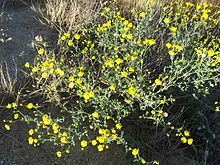Senecio gallicus, an annual plant of the Senecio genus and a member of the Asteraceae family is also one of those species who colonizes in isolated habitats where the environmental conditions could qualify as being difficult—widespread across southern France and the Iberian Peninsula in deserts and xeric shrublands, on steppes and salty dry coastal plains. S. gallicus is playing a predominant role in shaping patterns of genetic structure by presenting models of historical associations among population rather than patterns of ongoing gene flow.
English: French groundselSpanish: Azuzón de AlboránFrench: Séneçon de FranceItalian: Senecione gallicoSenecio gallicus has had more phylogenetic description because it is an exceptional species among halotypes with a known intraspecific phylogeographic structure which is also species specific. Comparisons of allozyme and chloroplast variation in this species indicate that it persisted in Pleistocene coastal refugia during glaciation periods.
The Endangered OneSenecio alboranicus, or
azuzón de Alborán, is reported to be endemic to and critically endangered on Isla de Alborán by ICUN. Alborán is 7.1 hectares and 600 metres (660 yd) by 265 metres (290 yd) of volcanic extrusion situated 48 kilometres (30 mi) from the port of Adra,
Almería on the Spanish coast and 39 kilometres (24 mi) from the
Melilla on the African coast (previously
Morocco).
S. alboranicus is one of the 26 plants, 20
vascular plants and 6
lichen cited as having inhabited the island, although, not all at the same time.Typical of the tenacious genus
Senecio, the small shrub Azuzón de Alborán colonizes areas that could be described as disturbed and unstabilized as it does live where there is an accumulation of volcanic ashes and shell laden sand, historically perturbed by natural events and human activities. Also typical, this species produces three generations of plants each year and is non-competitive; the middle generation of
S. alboranicus shares its part of the island with
Lavatera mauritanica and
Anacyclus alboranensis. Atypical of the genus, this species is a
halophile, growing in soils with a known high concentration of salt.Azuzón de Alborán can be found growing at altitudes between 0 metres (0 ft) and 15 metres (49 ft). The restricted size of the island and the rarity of the habitat make azuzón de Alborán particularly vulnerable to changes. Climatic conditions (quantity and distribution of rain,
soil salinity, etc.) and human activities (the lighthouse was once manned); there have been large fluctuations in the numbers of individuals each year. These fluctuations affect not only the number of individual plants but also their size and the number of flowers. The decline of this species could be caused by alterations generated by human presence (military occupancy, artificial environments, etc.) in addition to events like natural changes or biotic threats (competition, parasitism, diseases, etc.), alterations which probably not coincidentally describe many of the conditions that occurred from the mapping those years.Isla de Alborán is a
protected area, a
marine park and an important ecological area for the
Mediterranean and is especially protected by the
Barcelona Convention. Azuzón de Alborán is listed in Appendix I of Bern Convention. A permit is needed from the Ministry of Defence to visit Azuzón de Alborán on its island.
Specimens of Senecio gallicus have been collected at altitudes of 15 metres (50 ft) and 1,400 metres (4,600 ft) above sea level.
NativePalearctic:
Southwestern Europe: Alboran,
Formentera,
Ibiza,
Italy, France,
Monaco,
Morocco,
Portugal,
SpainNaturalized and NativePalearctic:
Western Asia:
IsraelSouthwestern Europe: Alboran,
Formentera,
Ibiza,
Italy, France,
Monaco, Morocco,
Portugal,
Sicily, Spain
Middle Europe:
BelgiumNorth Europe:
SwedenSynonymsSenecio gallicus Chaix var. calyculatus Emb. & Maire status incertainSenecio gallicus Chaix var. laxiflorus DC. status incertainSenecio gallicus Chaix var. sonchifolius Ball status incertainInfraspecific namesSenecio gallicus Chaix subsp. gallicusSenecio gallicus Chaix var. calyculatus Emb. & MaireSenecio gallicus Chaix var. laxiflorus DC.Senecio gallicus Chaix var. sonchifolius Ball 
